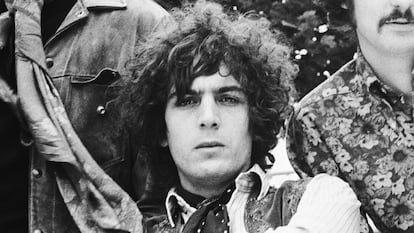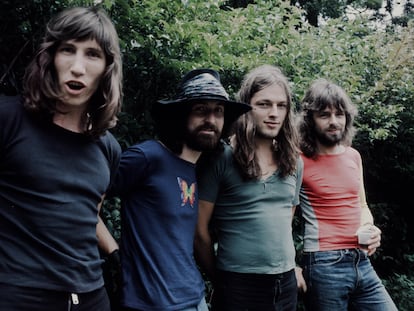Syd Barrett didn’t want to be a rock star but his Pink Floyd bandmates did
‘Have You Got it Yet’ tells the story of the band’s mercurial founding member, a crazy diamond who didn’t want to shine

When Syd Barrett decided he didn’t want to be a rock star, he returned to his true passion of creating vibrant, abstract paintings. Once a piece was completed, he would photograph and then destroy or paint over it. However, his bandmates in Pink Floyd — the psychedelic rock group he cofounded — had different dreams. Those differences came to a head one fateful day when Pink Floyd was on its way to pick up Barrett for a performance, but then decided to drive past his house without stopping. They never went back to pick up Syd Barrett.
The documentary film Have You Got It Yet? tells the tragic tale of the visionary singer, songwriter and guitarist that later Pink Floyd songs called the “crazy diamond” and “the lunatic.” The documentary offers a thorough account, featuring testimonials from his sister, bandmates, other musicians, and managers. But there are no sensational revelations, and the film includes only a few recorded performances and video clips from the band’s first album. Syd Barrett remains somewhat elusive and difficult to understand, even for those closest to him.
Syd Barrett, whose real name was Roger Keith Barrett, was the creative force behind the band that burst onto the British underground scene in 1966 at the UFO, a well-known venue in London. Influenced by the Beatles’ Revolver album, Barrett decided to depart from his blues background and explore psychedelia. He led the group in creating their debut album, The Piper at the Gates of Dawn, which featured a mix of sonic experimentation in its instrumental pieces and catchy melodies with lyrics inspired by Lewis Carroll. The album was recorded in Abbey Road, adjacent to the Beatles’ studio. Those were heady times for Pink Floyd.
But Barrett’s performances quickly deteriorated as he struggled to handle both the success and the negative effects of LSD. He would often forget his parts, fail to show up at concerts, or play different notes from the rest of the band. He only contributed one song to the second album. By 1968, he was no longer part of the group. Despite this setback, his former bandmates used this experience to evolve their sound and artistic aspirations. They went on to create one of the most influential bodies of work of their time, reaching new heights in the 1970s with albums like The Dark Side of the Moon.
Perhaps feeling remorse for kicking him out of the band, Roger Waters (who assumed leadership of Pink Floyd) and David Gilmour (who took over on vocals and guitar) helped Syd Barrett release a pair of solo albums in 1969 and 1970. Then he disappeared completely. After selling his song copyrights for peanuts, he withdrew to his mother’s house where he created and destroyed paintings, rarely venturing outside. Much later, Gilmour expressed regrets for never visiting Barrett. During the recording of Wish You Were Here in 1975, Barrett made a surprise appearance at the studio. His former bandmates were taken aback and hardly recognized their friend. The long-haired frontman had shaved his head and gained considerable weight. Barrett said Pink Floyd’s new music was “strange.”
The tabloids revived his memory from time to time. In their eyes, he was British rock’s broken toy and an object lesson in morality. His big mistake was not dying young like Brian Jones, Janis Joplin, Jim Morrison and Jimi Hendrix. Barrett’s exit was much less epic — diabetes and pancreatic cancer killed him in 2006 at the age of 60. He never boasted, nor did he even seem aware of the immense impact of the band he started. The late 1960s and 1970s — the golden age of rock — cannot be grasped without acknowledging Barrett’s influence.
Pink Floyd did remarkably well without Barrett, yet his presence always seemed to hover over their music. Brain Damage, the song that inspired the name of Pink Floyd’s most famous album, was originally titled The Lunatic. The song ends with haunting lyrics that seem to sum up Barrett’s journey: “And if the band you’re in starts playing different tunes, I’ll see you on the dark side of the Moon.” Years later, Barrett’s specter appeared again in Shine on You Crazy Diamond: “You were caught on the crossfire of childhood and stardom… Come on you raver, you seer of visions / Come on you painter, you piper, you prisoner, and shine!”
Sign up for our weekly newsletter to get more English-language news coverage from EL PAÍS USA Edition
Tu suscripción se está usando en otro dispositivo
¿Quieres añadir otro usuario a tu suscripción?
Si continúas leyendo en este dispositivo, no se podrá leer en el otro.
FlechaTu suscripción se está usando en otro dispositivo y solo puedes acceder a EL PAÍS desde un dispositivo a la vez.
Si quieres compartir tu cuenta, cambia tu suscripción a la modalidad Premium, así podrás añadir otro usuario. Cada uno accederá con su propia cuenta de email, lo que os permitirá personalizar vuestra experiencia en EL PAÍS.
¿Tienes una suscripción de empresa? Accede aquí para contratar más cuentas.
En el caso de no saber quién está usando tu cuenta, te recomendamos cambiar tu contraseña aquí.
Si decides continuar compartiendo tu cuenta, este mensaje se mostrará en tu dispositivo y en el de la otra persona que está usando tu cuenta de forma indefinida, afectando a tu experiencia de lectura. Puedes consultar aquí los términos y condiciones de la suscripción digital.
More information
Archived In
Últimas noticias
Most viewed
- Sinaloa Cartel war is taking its toll on Los Chapitos
- Oona Chaplin: ‘I told James Cameron that I was living in a treehouse and starting a permaculture project with a friend’
- Reinhard Genzel, Nobel laureate in physics: ‘One-minute videos will never give you the truth’
- Why the price of coffee has skyrocketed: from Brazilian plantations to specialty coffee houses
- Silver prices are going crazy: This is what’s fueling the rally











































